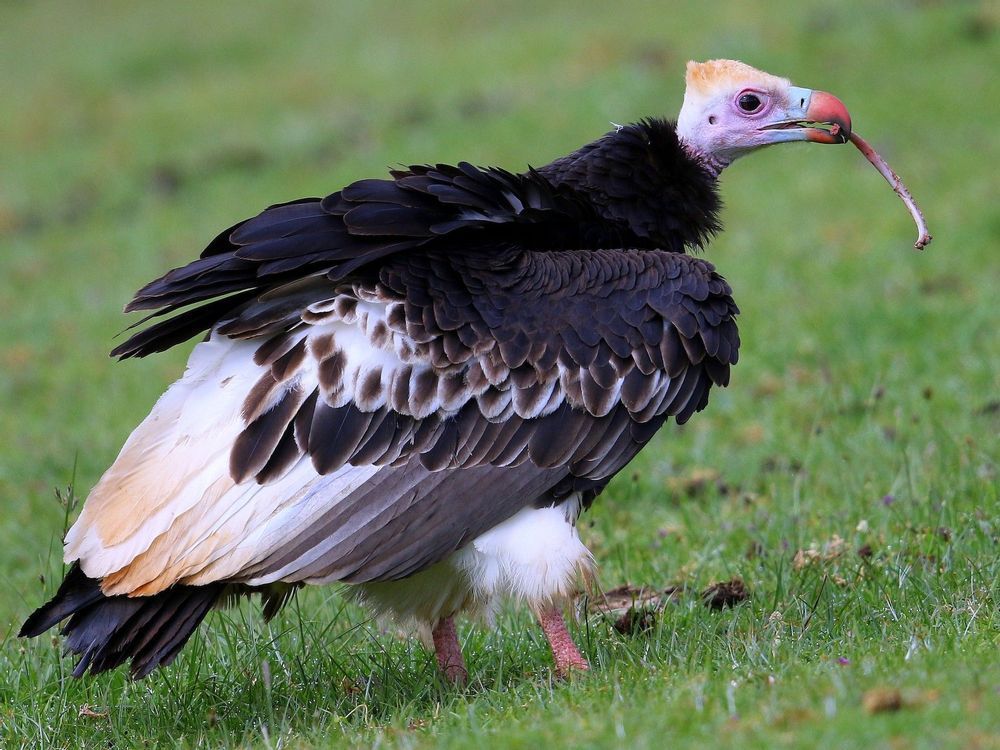White-headed vulture
Trigonoceps occipitalis
ORDER
Passeriformes
FAMILY
Pycnonotidae
GENIUS
Pycnonotus
2690
Observations
1900
Photos
26
Recordings
06
Videos

Description
The white-headed vulture is a medium-sized vulture, 72–85 centimetres (28–33 in) in length and with a wingspan of 207–230 centimetres (81–91 in). Females have an average weight of 4.7 kilograms (10 lb), while males are generally lighter at 4 kilograms (8.8 lb) or less. This species is unique among African vultures as it shows a degree of reversed sexual dimorphism, where females are somewhat larger than males.[3] It has a pink beak and a white crest, and the featherless areas on its head are pale. It has dark brown upper parts and black tail feathers. The feathers on its lower parts and legs are white, giving it its diagnostic image from below.[4][5] These vultures are easily distinguishable from all other vulture species as the plumage exhibits a strong contrast between black and white. Individual white-headed vultures can also be reliably identified based on a unique pattern in their median wing coverts
Distribution
The white-headed vulture is widely spread throughout sub-Saharan Africa, occurring from Senegal and Gambia east to Somalia and south to South Africa and Swaziland. It is locally uncommon to common. A total population of 10,500-18,750 individuals has been estimated, but newer estimates following recent declines suggest a population of just 5,500 individuals. It is estimated that 400 protected areas contain 1893 White-headed vulture nests, with 721 nests occurring in East Africa, 548 in Central Africa, 468 in Southern Africa and 156 in West Africa.[6] The species prefers mixed, dry woodland at low altitudes. It occurs at elevations of up to 4,000 m (13,000 ft) in Ethiopia, perhaps 3,000 m (9,800 ft) in Kenya, and can be found in thorny Acacia-dominated landscape in Botswana. It generally avoids human habitation [7] and are considered to be restricted to protected areas. For example, the Kruger National Park and neighboring conservation areas hold the largest population of the species in South Africa
Habitat
This species lives in mixed dry woodland at low altitudes, avoiding semi-arid thornbelt areas. They occur up to 4,000 metres in Ethiopia. This species is a long-lived resident that maintains the territory. They fly lower than other vultures and are often the first to arrive at a carcass. They nest and roost in trees, often in Acacia or baobabs. Clutches are usually only of one egg, laid during the dry season.
Feeding
Food and Feeding Behavior: Not strictly a large carrion-feeder, as its diet also includes small, helpless animals, including lizards, snakes, and insects, and it also pirates the prey of other predatory birds. This is often the first vulture to discover a large carcass, being second in that regard only the Bateleur, but it is also attentive to the movements of other scavenging species and adept at locating small carcasses on its own (Steyn 1982). This species also typically feeds alone. Although it is dominant over White-backed Vultures on a 1:1 basis, it loses out in competition when large numbers of the latter species arrive at a carcass. More often, it is "aloof" from other vultures (Mundy 1997
Breeding
Breeding: Breeding occurs annually. This species is non-colonial and probably territorial breeder, and adjacent nests are usually between 8-15 km apart. The large stick nest is usually placed in the crown of a tall, solitary acacia tree or baobab. Some pairs maintain two or more nests, which they use alternately. The clutch size is one egg. The parents share parental duties, including incubation, brooding, and feeding the chicks.
Threats
White-headed vulture populations have been declining since the early 1940s; it was classified as Vulnerable in the 2007 IUCN Red List. Recent indications that the species is rarer than previously thought have led to a status upgrade to Critically Endangered in 2015.[1] The main threats to white-headed vulture populations are reductions in the availability of suitable food sources (carcasses of medium-sized mammals and ungulates) and the loss of habitat to the spread of urban and agricultural developments. Poisoning through baits set for other carnivores such as jackals and hyenas, as well as targeted poisoning of vultures (by poachers who seek to prevent vultures from drawing attention to an illegal kill), is also an important factor. Secondary causes of decline is exploitation for the international trade in raptors and use in traditional medicines. The species is highly sensitive to land-use and tends to depart from degraded habitat, leading to high concentrations in protected areas. Potential introduction of the anti-inflammatory drug Diclofenac, which is fatal to all vultures of the closely related genus Gyps when ingested at livestock carcasses, may represent a potential future threat.[1] On the 20th of June 2019, the carcasses of 468 white-backed vultures, 17 white-headed vultures, 28 hooded vultures, 14 lappet-faced vultures and 10 cape vultures, altogether 537 vultures, besides 2 tawny eagles, were found in northern Botswana. It is suspected that they died after eating the carcasses of 3 elephants that were poisoned by poachers, possibly to avoid detection by the birds, which help rangers to track poaching activity by circling above where there are dead animals.
References
BirdLife International (2021) Species factsheet: Trigonoceps occipitalis. Downloaded from http://www.birdlife.org on 21/01/2021. Recommended citation for factsheets for more than one species: BirdLife International (2021) IUCN Red List for birds. Downloaded from http://www.birdlife.org on 21/01/2021.